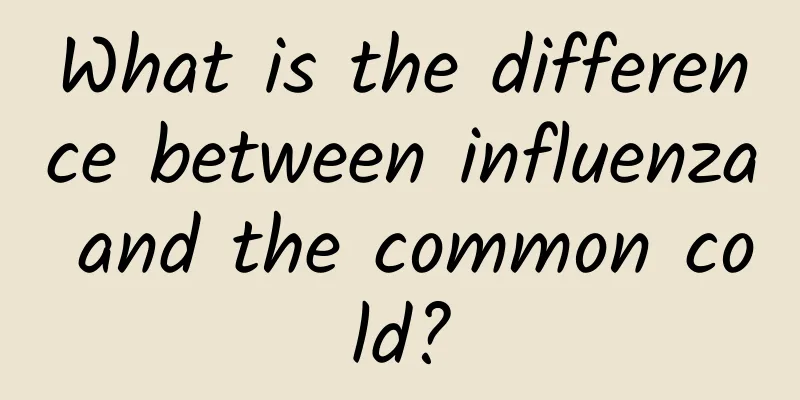What is the difference between influenza and the common cold?

|
Influenza and the common cold both show symptoms of a cold and cough, but in fact they are two different colds. The common cold has an acute onset, with symptoms of sneezing and runny nose, while influenza has an incubation period, has an acute onset, and is accompanied by a high fever. 1. The first difference between the common cold and influenza is that the common cold does not spread. The common cold, commonly known as "cold", is a common respiratory disease caused by a variety of viruses, a considerable number of which are caused by a certain serotype of rhinovirus. The common cold can occur in any season of the year, but is more likely to occur in winter and spring. Most common colds are sporadic and do not cause epidemics. Influenza, or flu for short, is a disease caused by influenza virus. It is highly contagious and can spread among a large population in a short period of time. Flu epidemics are common in winter and spring. There are three types of influenza viruses, namely A, B and C, among which infection with influenza A virus is more common. 2. The second difference is the symptoms . The common cold has an acute onset. Early symptoms include dry, itchy or burning throat, sneezing, nasal congestion, and runny nose. The runny nose starts as clear water and becomes thicker after 2 to 3 days. It may be accompanied by sore throat. There is generally no fever or systemic symptoms, or only low fever and headache. If there is no concurrent bacterial infection, the disease usually recovers in 5 to 7 days. The incubation period of influenza is usually 1 to 3 days. The onset is very acute, with fever at the beginning, which can be as high as 39℃ to 40℃, chills, general discomfort, dizziness, headache, sore limbs, sneezing and runny nose. After the high fever persists for 3 to 5 days, the systemic symptoms are alleviated, and respiratory symptoms such as cough gradually worsen. Based on the clinical manifestations and severity of the disease, influenza is divided into four types: simple type, pneumonia type, poisoning type, and gastrointestinal type. Those with mild illness can recover in 2 to 3 days, those with severe illness can take 1 to 2 weeks, and some can even last for a month. Common complications of influenza include pneumonia, viral myocarditis, and neurological complications. 3. The third difference is the treatment methods. Currently, for most people with common colds caused by viral infections, there is no effective antiviral drug that can directly kill the virus. The effective method is to rely on the human immune system to produce specific immunity to the virus. Therefore, supportive therapy should be the main treatment for colds, with special attention paid to rest, drinking plenty of water, and eating a light diet. Colds can lead to secondary bacterial infections, in which case antibiotics can be used appropriately for treatment. The same type of influenza virus can undergo genetic mutations in nature to form new virus subtypes. People who have not been naturally infected or immunized with effective influenza vaccines generally lack resistance to these mutated influenza virus subtypes and are easily infected. This is why influenza pandemics occur several years apart. |
<<: What are the symptoms of influenza?
>>: What are the characteristics of a short pulse?
Recommend
Who can't eat Korean ginseng?
Korean ginseng is a type of ginseng, which is a v...
What is malaria?
Have you ever heard of malaria? What kind of dise...
Pain in arm blood vessels
The swelling and pain in the blood vessels in the...
Complications after gastrostomy
Some patients with esophageal cancer or brain dea...
What are the symptoms of atypical rheumatoid arthritis?
Rheumatism is a chronic disease, which mainly occ...
Why does the cervical spine make a sound when moving?
For some people, when their cervical spine is sha...
There is a small fleshy ball on the testicle
If there is a small lump on the testicle, you sho...
Why is the back of the elderly's hand swollen?
For the elderly, every uncomfortable reaction in ...
The difference between electronic colonoscopy and colonoscopy
There are many types of colonoscopes, some are tr...
Causes of uneven teeth
There are many reasons for uneven teeth, which is...
What are the effects of drinking liquor on fitness?
It is strictly forbidden to drink alcohol when ex...
How to deal with anal bleeding? What should you pay attention to?
Anal bleeding should be treated promptly. If the ...
What are the effects of donating a kidney on the body?
The kidneys are the body's detoxification org...
What should I do if my child has spider nevi on his face?
If red spots appear on human skin and there are s...
What is the normal color of the tongue and why does it hurt?
The tongue is a magical part of the human body. I...









